Succulents come in a variety of colors. Some people may think of succulents as only being different shades of green when in reality, they can be found in a rainbow of colors. Pink succulents are beautiful, and their color can change depending on the amount and intensity of light they receive. They look great on their own or when paired with other succulents for a mixture of colors. Here are some of our favorite types of pink succulents.
1. Pachyphytum oviferum – Moonstones
Moonstones (Pachyphytum oviferum) are a type of succulent that come in several shades of pink, purple, mauve, and blue-green. They have plump oval-shaped leaves and originate from Mexico. These plants need bright sunlight to thrive and require well-draining soil for the best results. It is important to allow the soil to dry out before watering again, as overwatering can be detrimental. Moonstones are also known for their ability to tolerate mild frost, which allows them to survive in cooler climates without issue. With the right amount of care, these lovely succulents will add vibrant color and texture to any outdoor garden or indoor pot!
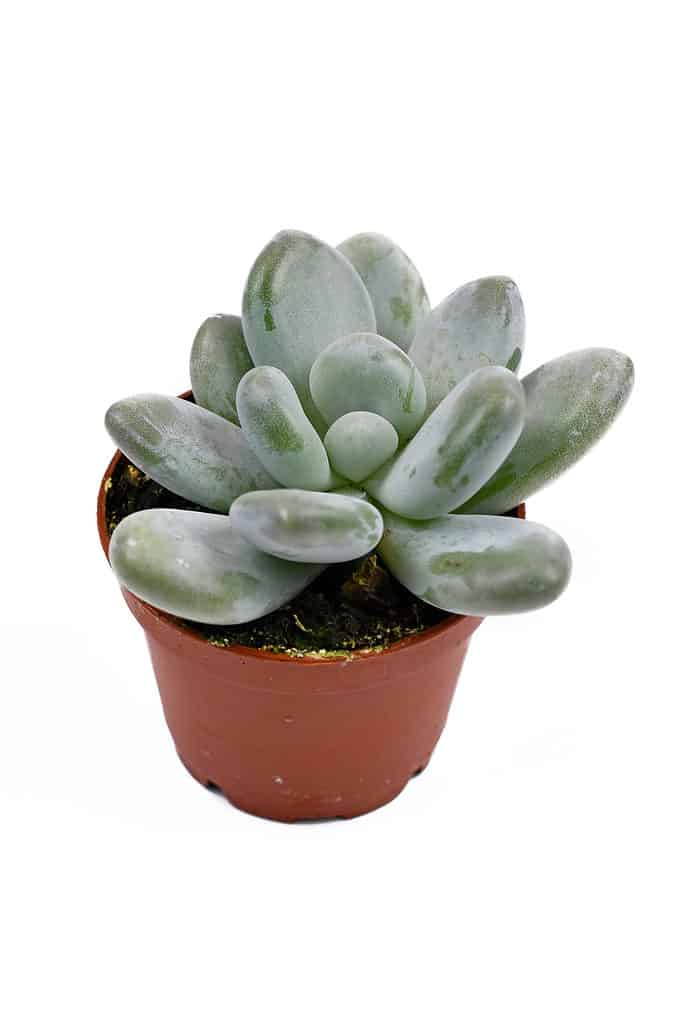
Moonstones have plump oval-shaped leaves which can present in shades of pink, purple, mauve, and blue-green.
©iStock.com/Firn
2. Echeveria ‘Perle von Nurnberg’
Echeveria ‘Perle von Nurnberg‘ is a unique succulent with alluring pink and purple tips on the ends of its leaves. The base of the leaves have a distinctive grayish-blue color, creating an eye-catching contrast when combined with the bright-colored tips. It’s important to note that this plant needs plenty of light in order for it to maintain its vibrant colors, so place them in full direct sun or use an indoor plant light. With proper care, you can enjoy these beautiful shades for decades to come!
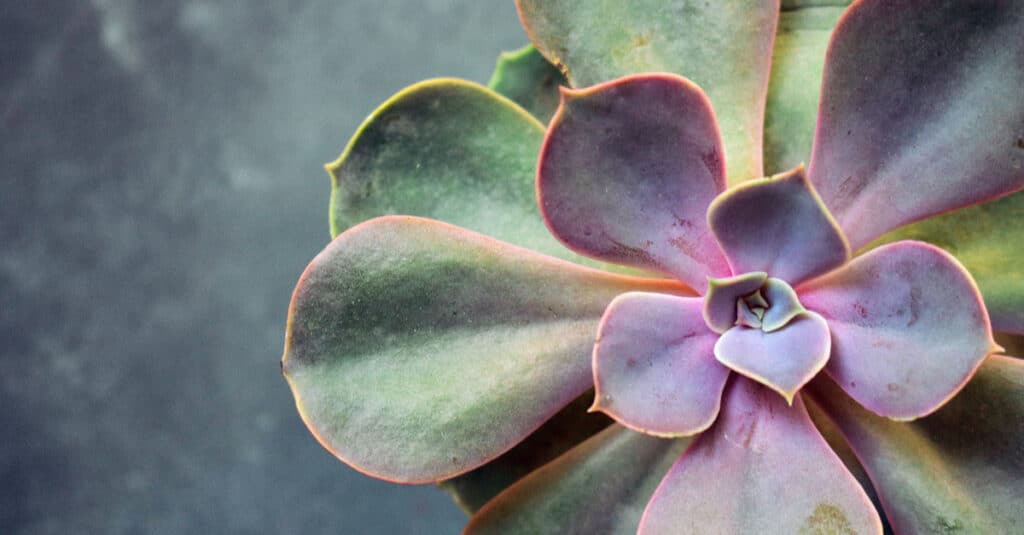
‘Perle von Nurnberg’ needs plenty of light in order for it to maintain its vibrant colors of pink and purple tips on the ends of its leaves.
©Inthemood/Shutterstock.com
3. Echeveria ‘Afterglow’
Echeveria ‘Afterglow’ is a pink succulent with purple-tinged leaves trimmed in pink around the edges. When given enough light, these plants will produce beautiful orange flowers. Although Echeveria ‘Afterglow’ can be planted directly into the soil, it is important to use a well-draining cactus mix when planting them in containers. Choose a pot made from clay or another breathable material to ensure proper drainage and aeration. With the right care and environment, your Echeveria ‘Afterglow’ will thrive!

‘Afterglow’ is a pink succulent with purple-tinged leaves trimmed in pink around the edges.
©Stickpen, Public domain, via Wikimedia Commons – License
4. Sedum rubrotinctum ‘Aurora’
Sedum rubrotinctum ‘Aurora’, commonly known as pink jelly beans, is a stunning succulent with many shades of pink and mauve. Unlike other plants, this succulent does best in direct sunlight, which will help to bring out its vibrant colors. It has low maintenance needs and only requires infrequent watering and plenty of light to thrive – making them perfect for those who don’t have time to fuss over their plants! Plus, they are very easy to propagate from cuttings, so you can generate loads of new plants to give to friends. Aurora is a pink succulent that all enthusiasts should consider adding to their collection!
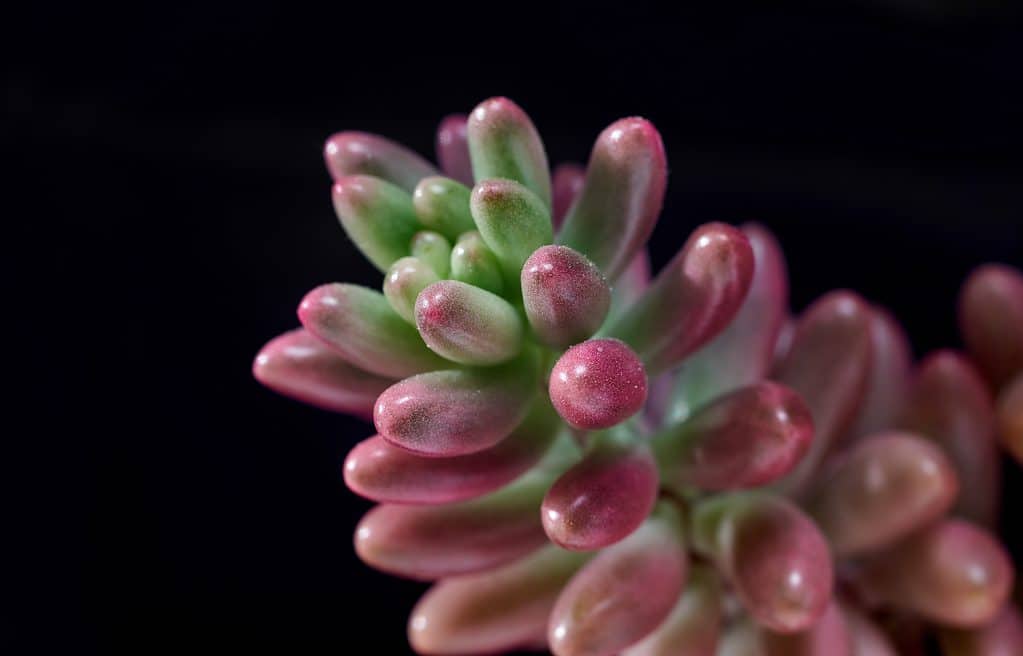
‘Aurora’, commonly known as pink jelly beans, is a stunning succulent with many shades of pink and mauve.
©Kateryna Puchka/Shutterstock.com
5. Graptopetalum ‘Copper Rose’
Graptopetalum ‘Copper Rose’ is an incredibly attractive pink succulent. Its colors of orange, red, and pink are arranged in a rosette pattern that adds visual interest to any space. Over time these rosettes will grow longer and longer until they trail over the side of their pot, making them ideal for use as hanging plants. As with most succulents, Graptopetalum ‘Copper Rose’ is quite easy to propagate and requires little attention once established. It does need well-draining soil and bright light if you want the colors to be at their brightest!
6. Crassula pellucida ‘Variegata‘ – Calico Kitten
The Crassula pellucida ‘Variegata’, or calico kitten plant, is a gorgeous pink succulent. It has heart-shaped leaves with marbled variegation of pink, green, and purple that turn bright purple when exposed to full sun. This trailing succulent looks gorgeous cascading over the side of a pot or hanging basket. When caring for this plant, it’s important to note that it should be watered only when the soil is completely dry. Overly moist soil can cause root rot and kill your plant quickly. With proper care, this stunning succulent will bring color and life to any home garden!

The calico kitten succulent has heart-shaped leaves that turn bright purple when exposed to full sun.
©iStock.com/MichelR45
7. Crassula perforata – String of Buttons
Crassula perforata (also known as string of buttons) is an especially beautiful pink succulent. Native to South Africa, this plant grows tall with plump leaves stacked on top of each other in a tower formation. The pointed leaves are light green and feature bright pink trimming along their edges. With more sun exposure, the color will become more vibrant and intense, creating a stunning display when placed together in a mass planting. This eye-catching succulent is sure to add some much-needed life and vibrancy to your garden!
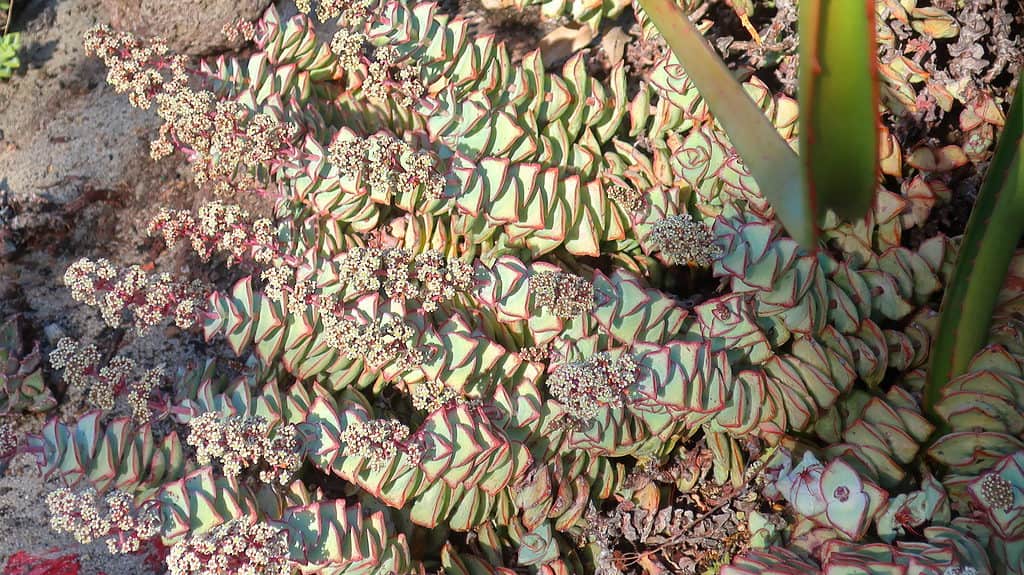
has leaves with a bright pink trim that becomes more vibrant the more it is exposed to sun.
©cultivar413 / Flickr – License
8. Anacampseros rufescens – Sand Rose
Anacampseros rufescens, native to South Africa, is a low-growing succulent that forms clumps. It is often called the sand rose or the sunrise succulent because of its vibrant colors. Its leaves are pink, green, and purple and are covered with white hair-like roots along the stems and around the plant’s leaves. Anacampseros rufescens prefers well-draining soil as it is susceptible to fungal diseases if left sitting in wet soil for too long. It also needs bright but filtered light for optimal growth. When cared for properly, this succulent can make an attractive addition to any garden or home decor!
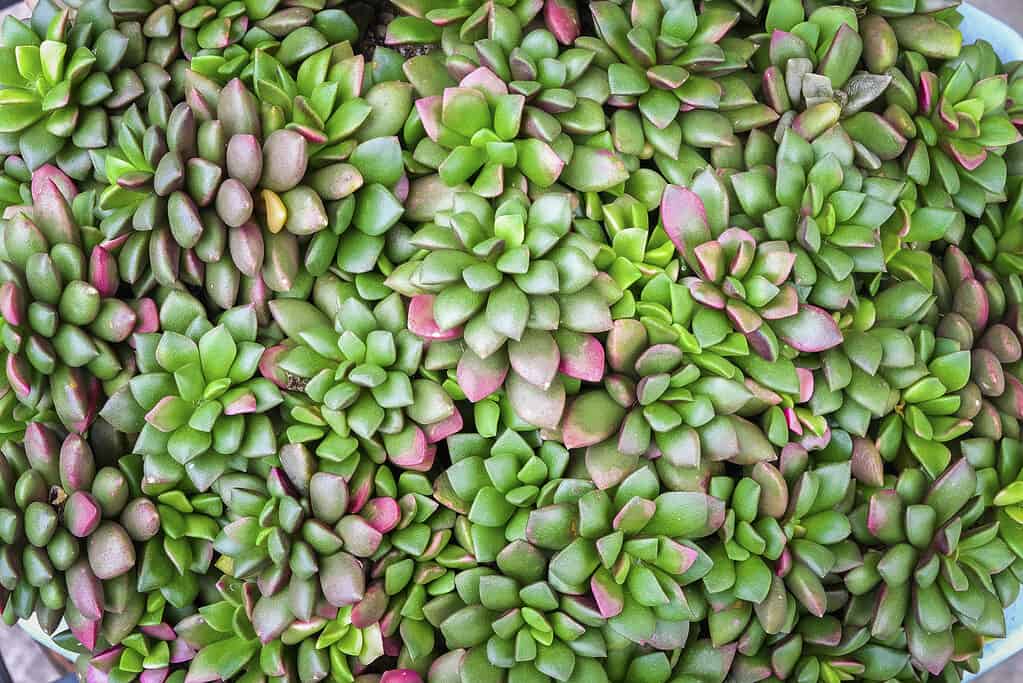
is a low-growing, brightly colored succulent that forms clumps.
©iStock.com/thewet
9. Graptoveria ‘Bashful’
Graptoveria ‘Bashful’ is a beautiful succulent that stands out for its bright pink hues. It is easily recognizable by its stemless rosettes that fan out in a circular pattern from the middle. The leaves are thick and plump, with an overall green coloration but showing spectacular shades of pink on the tips. These pink tones will become even brighter and more intense with more sun exposure. This plant prefers bright sunny locations to reach its full potential, so consider placing it near windows or outdoors if possible. Be sure to give it well-draining soil, as too much moisture can cause fungus issues or root rot. With a little love and attention, Graptoveria ‘Bashful’ will produce many offsets, giving you free plants.
How to Care for a Succulent
Water Requirements: Succulents need to be watered sparingly, as they are drought-tolerant plants. Water only when the pot feels light and the soil is completely dry, and then water thoroughly until water comes out of the drainage holes. Allow excess water to drain before returning your succulent to its pot or container.
Soil Requirements: Most succulents prefer well-draining soil with a pH between 6.0 and 7.5, such as cactus mix or other commercial succulent mixes available at garden centers and nurseries. If you’re using regular soil, make sure it contains vermiculite or perlite for better drainage and aeration.
Light Requirements: Succulents require lots of light in order to thrive — at least six hours per day is ideal if possible, though some species can tolerate lower amounts of light just fine (e.g., Haworthia). Avoid direct sunlight during the hottest part of the day (typically midday) as this can burn leaves, but otherwise, give them bright natural light whenever possible!
Fertilizer Requirements: Fertilizing isn’t necessary for most types of succulents unless you have a particularly large collection that needs extra help growing healthy roots and stems. However, if desired, you may use a balanced liquid fertilizer diluted every few months during warmer months (April through October). Be sure not to overfertilize, as this can cause root burn and damage your plant.
Summary of 9 Types of Pink Succulents
- Pachyphytum oviferum – Moonstones
- Echeveria ‘Perle von Nurnberg’
- Echeveria ‘Afterglow’
- Sedum rubrotinctum ‘Aurora’
- Graptopetalum ‘Copper Rose’
- Crassula pellucida ‘Variegata’ – Calico Kitten
- Crassula perforata – String of Buttons
- Anacampseros rufescens – Sand Rose
- Graptoveria ‘Bashful’
The photo featured at the top of this post is © Mauronarf, CC BY-SA 4.0
Sources
- : Patel RM, Qureshimatva UM, Maurya RR & Solanki HA (2016) A checklist of succulent plants of Ahmedabad, Gujarat, India. Tropical Plant Research 3(3): 686–693, Available here: https://pdfs.semanticscholar.org/44d8/72b0fad7b913d30445d42157d672a4237876.pdf
- Cabahug Raisa Aone, Nam Sang Yong, 2018/11/07, Propagation Techniques for Ornamental Succulents, 10.11623/frj.2018.26.3.02, Available here: https://www.researchgate.net/profile/Raisa-Aone-Cabahug/publication/328780647
- Bruyns, P. V. (2003). Three New Succulent Species of Apocynaceae (Asclepiadoideae) from Southern Africa. Kew Bulletin, 58(2), 427–435. https://doi.org/10.2307/4120625, Available here: https://www.jstor.org/stable/4120625
Thank you for reading! Have some feedback for us? Contact the AZ Animals editorial team.






